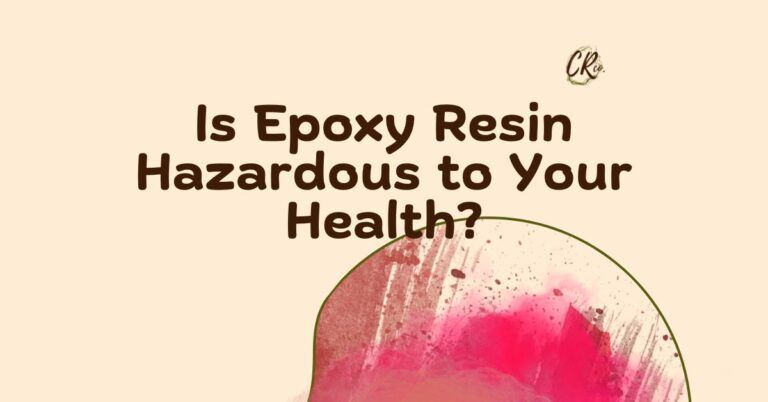Resin Art Safety Precautions
Working with resin can be an exciting and satisfying experience. However, it’s also important to understand the potential risks that come with it. These risks aren’t something to take lightly—exposure to resin fumes and contact with resin can result in health issues ranging from skin irritation to respiratory problems.
First off, let’s understand why resin safety matters. Resin contains chemicals that, when not handled properly, can be harmful. This includes volatile organic compounds (VOCs), which are chemicals that evaporate into the air and can be inhaled. Long-term exposure to VOCs has been linked to serious health issues like liver and kidney damage, and even cancer.
Personal Protective Equipment (PPE) is your first line of defense against these risks. This includes respirators, safety goggles, nitrile gloves, and lab coats or aprons. Using the right PPE can significantly reduce your exposure to harmful chemicals and protect your health.
Think of working with resin like cooking a complex meal. Just as you wouldn’t handle hot oil without a kitchen mitt, you shouldn’t work with resin without the right protective gear. Understanding and respecting the safety guidelines ensures that you can enjoy your resin projects without putting your health at risk.
Selecting the Right Respirator for Resin Work
Resin work requires a respirator to guard against inhaling those pesky volatile organic compounds (VOCs). But not any old respirator will do; you need one fitted with the right cartridges to filter out these harmful vapors.
Look for respirators labeled N95, N99, N100, or P100. These are equipped to handle airborne particulates and VOCs—perfect for resin use. Selecting the wrong type won’t do you much good.
The fit of your respirator is just as crucial. It must create a secure, airtight seal to keep unfiltered air from sneaking in. Fit testing can help you find the right size and style for your face. This is one step you shouldn’t skip!
Even if you’re working with a resin brand that claims to be non-toxic, wearing a respirator is still a good idea. Safety first, always!
If you wear glasses, opt for a glasses kit designed to fit with the respirator. This will ensure a snug fit without sacrificing your vision. Trust me, trying to wear goggles over your glasses can be a headache you don’t need.
Ensuring you have a proper respirator helps you breathe easy and focus on your resin projects without any lingering worries. It’s a small investment in your health that pays off big time.
Top Recommendation: Respirators for Resin Artists
Full Face Respirator
 Buy Now
Buy Now
Half Respirator with Goggles
 Buy Now
Buy Now
Essential PPE: Safety Goggles and Nitrile Gloves
Protecting your eyes and skin is key when dealing with resin. Safety goggles and nitrile gloves are your best friends here. Resin can splash or emit fumes that irritate your eyes, so goggles are non-negotiable. Look for goggles that fit snugly and offer full coverage around your eyes.
Unlike latex gloves, nitrile gloves are more resistant to chemicals and punctures, making them ideal for resin work. They provide a reliable barrier to keep resin off your skin, reducing the risk of dermatitis and other allergic reactions.
Always go for powder-free nitrile gloves. The powder can mix with resin and compromise your project. Plus, it’s just a cleaner and more comfortable option overall.
Regularly check your gloves for any signs of wear and tear. Gloves that have holes or thin spots won’t protect you properly. Replace them as soon as you notice any damage.
One last thing—never reuse your gloves. Single-use means just that. Dispose of them properly after each session to maintain the highest safety standards.
Top Recommendation: Nitrile Gloves
powder free nitrile gloves
 Buy Now
Buy Now
powder free nitrile gloves
 Buy Now
Buy Now
Proper Lab Attire: Lab Coats and Aprons
Wearing the right clothing is crucial when working with resin. Lab coats and aprons are essential for protecting your skin and clothes from accidental spills and splashes. These garments act as a barrier, keeping resin off your skin and preventing it from soaking through to your regular clothes.
When choosing a lab coat or apron, opt for materials that resist chemicals and are easy to clean. Look for coats and aprons made from rubber or coated fabrics. These materials are less likely to absorb resin and can be wiped down easily after use.
Make sure your protective clothing fits well. Loose sleeves or baggy clothing can be a hazard, potentially dipping into resin or knocking things over. A well-fitted lab coat or apron minimizes these risks.
Don’t forget to regularly clean and inspect your lab coat and apron. Resin build-up can compromise their effectiveness, so give them a good wipe-down after each session and check them for any signs of wear and tear.
Proper lab attire isn’t just about safety; it also makes your workspace more professional and organized. You’ll find that having a dedicated set of clothing for resin work makes the entire process smoother and more enjoyable.
Top Recommendation: Resin Art Aprons
These aprons are affordable and actually look cute! The pockets are invaluable, but be sure to wear an old long sleeved shirt underneath when crafting with resin. If you decide to wear short sleeves, be careful not to get resin on your skin. Although you likely will not see an immediate reaction on your skin, it will absorb into your skin and could potentially cause health issues in the future.
Apron for Resin Artist
 Buy Now
Buy Now
Apron For Resin Artist
 Buy Now
Buy Now
Ensuring a Well-Ventilated Workspace
A well-ventilated workspace is essential for safely working with resin. Good airflow helps disperse the volatile organic compounds (VOCs) released during the curing process, reducing their concentration and making the air safer to breathe. Without proper ventilation, you risk inhaling harmful fumes, even if you’re wearing a respirator.
Set up your workspace in a room with windows or exhaust fans. Keep windows open to allow fresh air to circulate and use fans to push out the fumes. If you can’t work near a window, consider investing in an air purifier with a VOC filter. This will help capture the harmful particles and improve air quality.
Using a ventilation system isn’t just about protecting your lungs—it’s about maintaining a safe environment. Poor ventilation can also lead to a build-up of fumes, creating a flammable atmosphere. Always follow the resin manufacturer’s guidelines regarding ventilation and be proactive about maintaining good airflow.
In addition to mechanical ventilation, try to position your workspace in open areas rather than small, enclosed spaces. Larger spaces disperse fumes more effectively, preventing them from concentrating in one area. If possible, set up an outdoor or garage workspace where the air circulation is naturally better.
Remember, a well-ventilated workspace not only protects your health but also makes for a more pleasant working environment. Keeping the air fresh and clean allows you to focus on your craft without worrying about the invisible risks of resin fumes.
NuWave Air Purifier
 Buy Now
Buy Now
Window Fan For Resin Art Studio
 Buy Now
Buy Now
The Role of Material Safety Data Sheets (MSDS)
Material Safety Data Sheets (MSDS) are your go-to source for all the specifics about the resin product you’re using. These documents answer the ‘what,’ ‘why,’ and ‘how’ of handling resin safely.
MSDS provide detailed information on the chemical composition of the resin. They outline any potential hazards associated with each component. This knowledge helps you take proactive steps to safeguard your health.
Each MSDS includes recommended safety gear. This ensures you’re using the appropriate PPE for your specific resin product. Whether it’s a particular type of glove or respirator cartridge, the MSDS has you covered.
These sheets also list first aid measures. Knowing what to do in case of an accident can be a game-changer. From skin contact to accidental ingestion, the MSDS gives you clear guidelines on immediate actions to take.
Disposal procedures are another key feature. Improper disposal of resin can harm the environment. The MSDS provides instructions on how to dispose of both unused resin and contaminated PPE properly.
Reading the MSDS might seem tedious, but it’s a vital step. These sheets can usually be found on the manufacturer’s website or included with the product. It’s time well spent for peace of mind and safety.
Here is an exaple of the first cou;le of pages =of MSDS sheets for a popular brand of epoxy resin. As you can see, there is information about the different types of health issues that may be caused from using the rpoduct. these shetets are a treasure trove of information if you are looking to see what type of precautions should be taken. It is always a good idea to search for the MSDS sheets of the particular resin brand you are using and give them a once over before using the product. There is information regarding what to do in all types of emergency situation that may arise while using the product.
If you have further questions about how to read these sheets or how to find them, comment below and I would be happy to help. Many times, if you email a company, they are be happy to send the MSDS sheets to you for whatever product you may be using. Usually, they can be found with a quick Google search as well.


Here are links to MSDS sheets for some of the most popular Epoxy Resins on the market today:
Allumilite MSDS Craft Resin MSDS Let’s Resin MSDSBest Practices for Mixing Resin

The way you mix resin directly impacts the quality and safety of your project. Improper mixing can lead to issues like incomplete curing and potential safety hazards. This isn’t just about getting a perfect finish; it’s about ensuring a safe working environment.
Start by reading the instructions on the resin package carefully. Different brands and types have their own specific mixing ratios. Ignoring these can result in a batch that won’t cure properly, which means more fumes and a mess to clean up.
Using accurate measurements is crucial. Invest in a good digital scale or measuring cups specifically for resin. Eyeballing it won’t cut it; precision is key.
Mix thoroughly but methodically. Start slowly to combine the components evenly before speeding up. Make sure you’re scraping the sides and bottom of your mixing container frequently. This ensures all the resin and hardener are fully integrated.
Take your time here. It’s tempting to rush, but a couple of extra minutes mixing can save you a lot of trouble down the line.
Doing this in a well-ventilated area is essential. The mixing process can release additional fumes, so continue to prioritize good airflow in your workspace.
Wear protective gear during mixing, including your respirator, gloves, and goggles. This ensures you’re protected throughout the entire process. Never underestimate the importance of PPE at this stage.
Incorporating these best practices not only improves the quality of your resin projects but also minimizes health risks, making your crafting experience safer and more enjoyable.
Preventing Accidental Ingestion and Contamination
 Keeping food and drink away from your resin workspace is essential. Resin can easily contaminate anything it comes into contact with, and ingesting resin or its fumes can seriously harm your health.
Keeping food and drink away from your resin workspace is essential. Resin can easily contaminate anything it comes into contact with, and ingesting resin or its fumes can seriously harm your health.
Never eat or drink while working with resin. Designate a separate area away from your workspace for any breaks or meals. This separation minimizes the risk of accidentally ingesting resin or transferring it to your mouth through contaminated hands or utensils.
Make it a strict rule to wash your hands thoroughly after each resin session, even if you’ve been wearing gloves. Resin particles can linger and transfer to other surfaces or skin, increasing the risk of accidental ingestion.
If you have pets or kids around, keep your resin supplies securely stored out of their reach. Children and pets are naturally curious and may try to touch or even taste resin materials, which can lead to serious health issues.
Educate everyone in your household about the potential dangers of resin and the importance of keeping it separate from food and drink areas. Awareness helps ensure that everyone stays safe.
Emergency Preparedness for Resin Artists
Being prepared for accidents is crucial when working with resin. Even with the best precautions, mishaps can happen. The key is to be ready to handle them effectively and safely.
Keep a well-stocked first aid kit in your workspace. It should include essentials like bandages, antiseptic wipes, and burn ointment. Treat minor injuries promptly to avoid complications. Additionally, consider installing an eyewash station or having saline solution on hand for immediate eye irrigation if resin gets into your eyes. Check out this affordable, portable eye washing station from Amazon below. This product has actually saved me on a couple of occasions and I recommend all artists purchase one. I am a messy artist and sometimes I mess up and rub my eyes, but it can certainly happen to anyone and having an eye wash station is key in these situations.
Eye Was Station for Resin Artists
 Buy Now
Buy Now
First Aid Kit for Resin Artists
 Buy Now
Buy Now
Proper Storage for Epoxy Resin
When it comes to storage, keep your resin products in a cool, dry place, away from direct sunlight. Extreme temperatures can affect the resin’s quality and performance, so maintaining a stable environment helps ensure its longevity. Make sure the containers are sealed tightly to prevent spills and limit exposure to air, which can cause it to thicken or cure prematurely.
Dispose of resin waste properly. Follow the guidelines provided in the Material Safety Data Sheets (MSDS) for your particular resin. Never pour leftover resin down the drain, as it can harden and cause blockages. Instead, allow it to cure fully in a disposable container before placing it in the trash.
Having a dedicated resin workspace simplifies both cleanup and safety management. This space should be organized with all your tools and materials within easy reach, and it should be an area where food and drink are strictly prohibited. An orderly workspace not only enhances your efficiency but also ensures that you’re always prepared for any emergencies that might arise.
Also, remember to protect your workspace from resin spills. Check out Best Silicone Craft Mats For Resin Artists for my top recommendations on workspace resin art mats.
Also, if you want to keep your resin art studio organized, you have to check out the Broview Storage bins. They are, hands down, the best product I have found for storing all my resin art supplies. They are portable, come in multiple sizes, and, most importantly, they look amazing in my studio. For a full review, check out Ultimate Guide to Organizing Resin Supplies: Broview Storage Bins:

Conclusion
By being prepared for emergencies and storing your resin materials properly, you can enjoy your resin projects with peace of mind, knowing that you’ve taken all the steps to ensure a safe and efficient workspace.
Finally, always remember that when working with resin, the possibilities are endless!
Stay safe and have fun. I cannot wait to see what you create.





